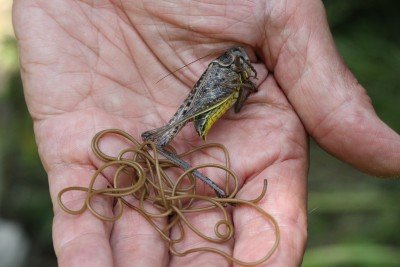
Wolf worms, particularly known for their parasitic lifestyle, need a little help from their friends—specifically from their hosts, which can be anything from mammals to birds. Imagine a tiny guest moving into your house and turning it into a cozy home. While it might seem cute at first, it can lead to some unwanted consequences for the host. The question arises: how can researchers learn more about these intriguing worms without harming their temporary homes? Let’s dive into the world of wolf worms and explore this critical balance between scientific discovery and animal welfare.
Understanding Wolf Worms
Wolf worms belong to a group called **myiasis-causing larvae**. These are fly larvae that invade living animals, often causing a variety of health issues. Imagine a little intruder setting up camp inside a cozy space—sounds uncomfortable, right? Depending on the species, these worms can affect different hosts in various ways. Some may cause infections or inflammation, while others lead to more severe conditions if left untreated.
The lifecycle of wolf worms is fascinating. They begin as eggs laid by flies on the host’s skin or in their environment. When the eggs hatch, the larvae enter the host, often causing discomfort. This invasion can lead to noticeable symptoms, making it important for hosts to receive the right care. Studying wolf worms offers vital insights into their behavior, life cycles, and potential treatments for affected animals.
The Importance of Studying Wolf Worms
You might be wondering, “Why study wolf worms at all?” Well, understanding them can shed light on the intricate relationships between parasites and their hosts. For instance, researchers can discover how these worms interact with the immune system of their hosts, which could be crucial for developing treatments for infestations.
Moreover, studying wolf worms can help scientists understand broader ecological impacts. By examining how these parasites affect animal populations, researchers can gain insights into the overall health of ecosystems. Just like a chain reaction in a line of dominoes, the decline in one species can influence others, leading to significant ecological changes.
Non-Invasive Research Techniques
Now, let’s get into how researchers can observe wolf worms without causing harm. One promising approach is the use of **non-invasive imaging techniques**. Just like having a window into another world, these methods allow scientists to visualize the presence of wolf worms inside their hosts without needing to dissect them. Techniques such as ultrasound or MRI can help researchers monitor the worms’ activity and growth.
Another approach is to collect samples from the host’s environment. For instance, researchers can analyze the soil where the host lives or look for signs of infestation without disturbing the host itself. By understanding the environmental conditions that favor these worms, scientists can devise better strategies for preventing infestations.
Behavioral Observations
Behavior is a fascinating aspect to explore when studying wolf worms. Researchers can observe how infected hosts behave in their natural habitats. For instance, an infected animal may exhibit changes in feeding habits or social interactions due to the discomfort caused by the worms.
By closely monitoring these behaviors, scientists can gain insights into the impact of parasitic infections on animal populations. For example, if infected animals tend to isolate themselves, this could lead to decreased breeding rates, affecting the population’s overall health. Such observational studies can be conducted with minimal disturbance to the animals, combining ethical research practices with valuable scientific inquiry.
Ethical Considerations in Research
Ethics in research is crucial, especially when it involves living creatures. Researchers must ensure that their methods prioritize the well-being of the hosts. Protocols such as obtaining necessary permits and following humane treatment guidelines are essential to maintain ethical standards.
In addition to obtaining approval, researchers often collaborate with veterinary professionals to ensure that any procedures do not cause undue harm to the host animals. This partnership helps balance the goals of scientific discovery and animal welfare, creating a more ethical research environment.
The Role of Technology in Studying Wolf Worms
Advancements in technology have opened new doors for studying wolf worms while minimizing harm to hosts. For instance, **molecular techniques**, such as PCR (Polymerase Chain Reaction), allow researchers to detect the presence of wolf worms in hosts without needing to harm them. This method can identify species, determine their life stages, and even assess genetic diversity—all from a small sample!
Furthermore, **data analysis software** can help researchers monitor trends and patterns related to wolf worm infections. By crunching the numbers, scientists can uncover valuable information regarding outbreaks or environmental factors contributing to infestations. It’s like having a high-tech toolbox at their disposal, enabling them to gather valuable insights without the ethical dilemmas associated with traditional methods.
Future Research Directions
As our understanding of wolf worms grows, so does the potential for innovative research techniques. Future directions may include exploring more refined non-invasive techniques and advanced imaging methods. Researchers might also look into the use of more sophisticated data analytics to track infestations and their effects across various ecosystems.
Additionally, interdisciplinary collaborations—bringing together ecologists, veterinarians, and technologists—will likely pave the way for new insights into managing and understanding wolf worm infestations. This kind of teamwork can lead to more effective methods for controlling these parasites while keeping their hosts safe and healthy.
In conclusion, studying wolf worms doesn’t have to mean sacrificing the well-being of their host animals. By using a combination of non-invasive methods, behavioral observations, and advanced technologies, researchers can gain valuable insights into these fascinating parasites while maintaining ethical standards. As we continue to learn about the interactions between wolf worms and their hosts, we can hopefully find solutions that benefit both organisms in this complex relationship.
